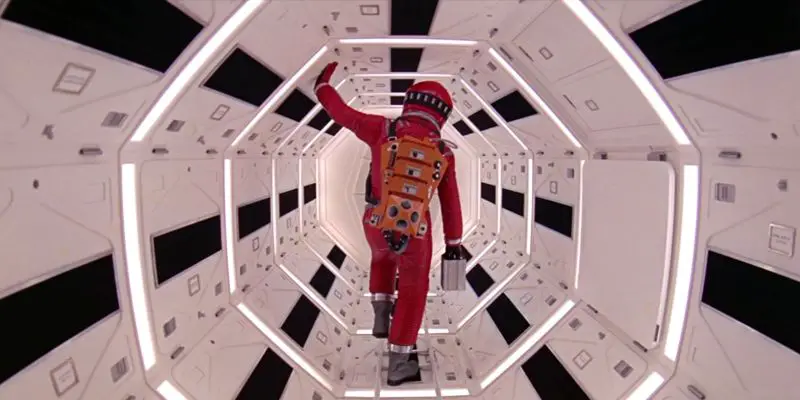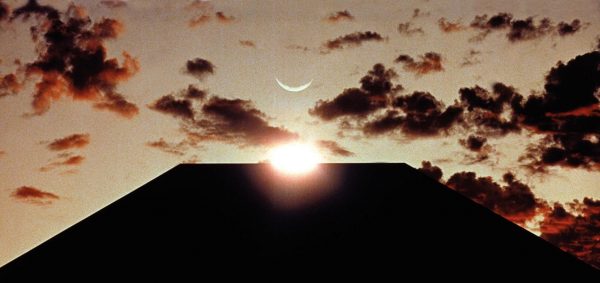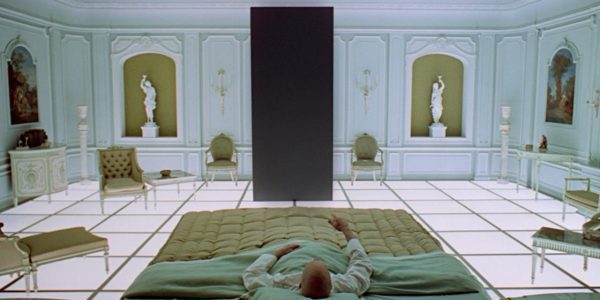2001: A SPACE ODYSSEY: Clubbing The Lower Animal

A bi-product of passion and experimentation gone wrong, Mike has…
Stanley Kubrick’s classic sci-fi epic, 2001: A Space Odyssey, is a fictional transcendence of classic Greek mythos through the ubiquity of the motion picture camera. As the film’s title suggests, this is Greek philosopher Homer’s The Odyssey told on the grandest of scales and sparing no expense that 20th Century cinema had to offer. According to philosopher Carl Jung, myths are the “culturally elaborated representations of the contents of the deepest recess of the human psyche: the world of the archetypes.”
As such, 2001 makes tremendous leaps forward in longstanding narrative traditions that have been passed down from the epitome of Western culture. This was Kubrick, after all, and he wasn’t going to give the viewer an easy time or spoon feed answers to the cryptic symbolism. The film is ostensibly draped in ambiguity, and it leads down a path that rejects materialism in favor of spiritual enlightenment. The final act is overly concerned with the impact that light has on the body; how illumination can take a lifetime to understand and transform decaying flesh into the Übermensch.
Having heard people say that there isn’t much going on in 2001 or simply not “getting it,” what follows is a small breakdown of the big thematic material that makes up the masterpiece.
It’s All Greek To Me
2001 noticeably takes its biggest inspiration from, perhaps, the archetypal story of all stories, The Odyssey. The main character of the movie is astronaut Dr. Dave Bowman (Keir Dullea). Dave and his co-pilot, Frank Poole (Gary Lockwood), are responsible for transporting the first manned-mission to Jupiter. After having discovered a subterranean Monolith on the moon, NASA sends the group of scientists into the unknown to try and crack the ringing message emanating from the obsidian rectangle. The only other crew member awake during flight is HAL (voiced by Douglas Rain), the ship’s AI and guidance protocol.

In Homer’s poem, Odysseus is an archer attempting to return home after the Trojan War. Kubrick said of the character and setting allusions in the film,
“It occurred to us that for the Greeks the vast stretches of the sea must have had the same sort of mystery and remoteness that space has for our generation.”
Along with the indirect reference of Bowman to Odysseus and the more obvious ocean to space, the other big notable comparison to make is the artificial intelligence system, HAL to the Cyclops. The myopic villain of 2001 slowly reveals his ulterior motives for Bowman, as Cyclops attempts to thwart Odysseus in his quest. Both nemeses are placed as roadblocks by the gods to stop the adventurer in his quest.
HAL is only acting the part that Big Brother wants him to perform as NASA has hidden a secret truth from Dave. All that the Cyclops wants is to kill Odysseus in the poem. Here the fictional conventions are being expanded, elevated, rewritten and become symbolic for the sake of updating and transforming the old text.
Not only is The Odyssey an obvious signifier within 2001: A Space Odyssey, but a more esoteric myth lies within the picture. The legend of Theseus slaying the Minotaur is essentially the entirety of 2001 (more on that below). To make the literary signal all the more intriguing is that a Minotaur had been used in Kubrick’s catalogue before, though not interiorly.
His first full-length feature, Killer’s Kiss, was created through Kubrick’s own Minotaur Productions. After 2001, a semiotic Minotaur’s maze becomes the focal point of the denouement in The Shining, another Kubrick film ultimately about the saturating nature of light (it’s in the title, wink wink).
Dark Planet Illuminate
“The Dawn of Man” is 2001’s opening chapter. The earth is cooling from eons of destructive volcanic activity, and the land is being run by denizens who only portray chaotic sensibilities. We see Ape-man as a pre-Adam, a beastly thing that skulks around as an inept scavenger. We get the sense that this Pre-man will starve to death before he becomes a being worth regarding. He wars with other factions of his family, as they vie for dominance over the earth from which they came.
But the invisible gods have other plans for Ape-man. One night they send down a Monolith — a rectangular, obsidian Tree of Knowledge — to help awaken the Cro-Magnon. In the morning, as the sun rises, Ape-men approach the dark giver of light and it causes rapid a evolution in their minds. The idea quickly raised by the film, an intellectualism which is reverberated in The Bible, is that knowledge is actually an act of violence.
When Adam and Eve eat the fruit of the knowledge of good and evil, their eyes are opened but they are immediately subjugated to death as punishment. The first transgression after they are kicked out of Eden is their offspring war against one another. Cain kills Abel, which is a continuous and extreme act of violence. Almost the exact same happens in 2001. Once Ape-man has acquired knowledge, or enlightenment, the first thing he does is create personal death for him and others.
At first he kills to eat, but the damning action of consuming life is only sinful, self-preservation. He then kills his fellow Pre-man and passes down the instrument of death to his descendants. The film displays this in the most famous of all match-cuts, as the bone used in the first murder is thrown in the air and transforms, through the edit, into a nuclear missile silo pointed back at earth.

To write analytically about the ill of man’s inhumanity is only to show a portion of the tale. Not only is man killing others but, paradoxically, he is also killing the brute form of himself through the consumption of enlightenment. The Theseus story, from Greek mythology, represents the slaying of man’s “lower animal” side in order to transcend the original, low life state.
This is what Kubrick so brilliantly and cleverly hid, and yet ironically showed in filmed simulations. By eliminating typical plot devices, the story is told almost entirely through the images and sounds, and this spills over into the metaphorical layering of the movie. Theseus killing the Minotaur is mirrored by the knowledgeable Ape-man murdering the uninitiated man, or the animal side within him. 2001 is postulating that only a select few, an exclusive club of individuals, are capable of attaining such meaningful and god-like activity.
Here Comes The Sun
“Thus Spoke Zarathustra“, Friedrich Nietzsche’s philosophical, anti-religious proverb, is considered the height of Germany’s turn-of-the-century racism and specific anti-Semitism. It took time for the beliefs of prejudice to come into prominence, and by Nietzsche’s years most Germans considered themselves to be the master race. The nation of Aryans had their holy text in “Zarathustra”, and Hitler would eventually use Nietzsche’s book as proof that the people could overcome their place and become the Übermensch (“supermen”) to dominate earth.
Whether or not Nietzsche held these specific bigoted ideas is still contentiously open for debate today. In “Thus Spoke Zarathustra”, man as a race is merely just a bridge between animals and “the Overman.” Nietzsche also made the point that the Overman was not the end result for a person, but more a journey towards self-mastery and physical transfiguring. In 2001, Ape becomes man becomes Dave becomes The Star Child through the process of capturing light, both literally and figuratively.
Now, this is where all things symbolic within and without the picture become metatextually aware in 2001. Films are a supreme method of capturing and reconstructing light. The esoteric symbolism that a film plays back can also be doubled as the film enacts what the characters experience.
In 2001, the entire plot that has existed to this point fades away when Dave arrives at Jupiter. HAL is also the camera, recording and observing the events play out. Dave goes out into the vacuum of space and enters the massive Monolith that is left there by the invisible gods. The film abandons all of the previously held narrative meaning, and expectations, as light fills the screen and dominates it for the rest of the picture.

Kubrick goes on to examine light’s endless appeal and charm as he experiments with prisms and a myriad of photographic techniques that are as revolutionary today as they were back in the ’60s. The film ceases to be anything but a tribute to the magnitude that light has had in the universe. Dave can’t comprehend what he is living through, and neither can the viewer (through HAL’s shutter).
Dave begins to violently shake as his body is transported to ethereal realms indescribable, and the viewer’s gaze becomes trance-like, fixed upon mind-blowing images flooding out of the screen and consuming all minds concerned. The voyeurs’ trance of light is the transcendence of Dave. These visions are what the Ape-man saw. The sacred quest only subsides for a moment as Dave comes down out of the clouds in a moment of reflection.
In the end Dave sits at a proverbial “Last Supper” and looks back over his life, similarly how cinema replays the past in the present, From Dave leaving the escape-pod that left the phallic shaped Discovery One ship, to Dave’s penetration of the unknown, he walks out into a life of contemplation. He looks down empty rooms and corridors that will one day be filled with his presence. So he sits where he must for a time, leaning and looking where he will go next.
As the days pass he finally lays down for the final rest and before him reappears the Monolith once more. Dave extends his hand for one last trip, as death presides over him like the ultimate adventure. The camera moves into the Monolith via Dave’s point of view. Then we see The Star Child, a reconfigured Dave, looking back at earth. He is no longer a fragile beast, nor the violent man but the Overman who has overcome the world.
The Übermensch has arrived, via storytelling, as the imperceptible hands of mystical illumination guided him. HAL, specter participant of the gods (i.e Kubrick), seeing all, recounts the prose of a primitive species whose only concern is to be remade.
What do you make of 2001: A Space Odyssey?
Does content like this matter to you?
Become a Member and support film journalism. Unlock access to all of Film Inquiry`s great articles. Join a community of like-minded readers who are passionate about cinema - get access to our private members Network, give back to independent filmmakers, and more.
A bi-product of passion and experimentation gone wrong, Mike has spent most of his time in the field couch surfing and growing a comb-over. Several of his favorite films are Rashomon, Vertigo, Apocalypse Now, and The Naked Gun.













